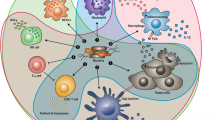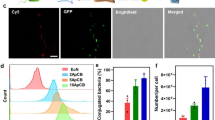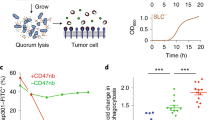Abstract
Increasing the specificity of chemotherapy may improve the efficacy of cancer treatment. Toward this aim, we developed a strain of bacteria to express enzymes for selective prodrug activation and non-invasive imaging in tumors. β-glucuronidase and the luxCDABE gene cluster were expressed in the DH5α strain of Escherichia coli to generate DH5α-lux/βG. These bacteria emitted light for imaging and hydrolyzed the glucuronide prodrug 9ACG to the topoisomerase I inhibitor 9-aminocamptothecin (9AC). By optical imaging, colony-forming units (CFUs) and staining for βG activity, we found that DH5α-lux/βG preferentially localized and replicated within CL1-5 human lung tumors in mice. The intensity of luminescence, CFU and βG activity increased with time, indicating bacterial replication occurred in tumors. In comparison with DH5α-lux/βG, 9AC or 9ACG treatment, combined systemic administration of DH5α-lux/βG followed by 9ACG prodrug treatment significantly (P<0.005) delayed the growth of CL1-5 tumors. Our results demonstrate that prodrug-activating bacteria may be useful for selective cancer chemotherapy.
This is a preview of subscription content, access via your institution
Access options
Subscribe to this journal
Receive 12 print issues and online access
$259.00 per year
only $21.58 per issue
Buy this article
- Purchase on Springer Link
- Instant access to full article PDF
Prices may be subject to local taxes which are calculated during checkout






Similar content being viewed by others
References
Higuchi T . Pharmacy, pharmaceutics and modern drug delivery. Am J Hosp Pharm 1976; 33: 795–800.
Kubo SH, Cody RJ . Clinical pharmacokinetics of the angiotensin converting enzyme inhibitors. A review. Clin Pharmacokinet 1985; 10: 377–391.
Wallace PM, MacMaster JF, Smith VF, Kerr DE, Senter PD, Cosand WL . Intratumoral generation of 5-fluorouracil mediated by an antibody-cytosine deaminase conjugate in combination with 5-fluorocytosine. Cancer Res 1994; 54: 2719–2723.
Cheng TL, Wei SL, Chen BM, Chern JW, Wu MF, Liu PW et al. Bystander killing of tumour cells by antibody-targeted enzymatic activation of a glucuronide prodrug. Br J Cancer 1999; 79: 1378–1385.
Huber BE, Richards CA, Krenitsky TA . Retroviral-mediated gene therapy for the treatment of hepatocellular carcinoma: an innovative approach for cancer therapy. Proc Natl Acad Sci USA 1991; 88: 8039–8043.
Agrawal N, Bettegowda C, Cheong I, Geschwind JF, Drake CG, Hipkiss EL et al. Bacteriolytic therapy can generate a potent immune response against experimental tumors. Proc Natl Acad Sci USA 2004; 101: 15172–15177.
Cheong I, Huang X, Bettegowda C, Diaz Jr LA, Kinzler KW, Zhou S et al. A bacterial protein enhances the release and efficacy of liposomal cancer drugs. Science 2006; 314: 1308–1311.
Pawelek JM, Low KB, Bermudes D . Tumor-targeted Salmonella as a novel anticancer vector. Cancer Res 1997; 57: 4537–4544.
Zhao M, Yang M, Li XM, Jiang P, Baranov E, Li S et al. Tumor-targeting bacterial therapy with amino acid auxotrophs of GFP-expressing Salmonella typhimurium. Proc Natl Acad Sci USA 2005; 102: 755–760.
Fujimori M, Amano J, Taniguchi S . The genus Bifidobacterium for cancer gene therapy. Curr Opin Drug Discov Devel 2002; 5: 200–203.
Yu YA, Shabahang S, Timiryasova TM, Zhang Q, Beltz R, Gentschev I et al. Visualization of tumors and metastases in live animals with bacteria and vaccinia virus encoding light-emitting proteins. Nat Biotechnol 2004; 22: 313–320.
Seo N, Tokura Y . Downregulation of innate and acquired antitumor immunity by bystander gammadelta and alphabeta T lymphocytes with Th2 or Tr1 cytokine profiles. J Interferon Cytokine Res 1999; 19: 555–561.
Seo N, Hayakawa S, Tokura Y . Mechanisms of immune privilege for tumor cells by regulatory cytokines produced by innate and acquired immune cells. Semin Cancer Biol 2002; 12: 291–300.
Genestier L, Kasibhatla S, Brunner T, Green DR . Transforming growth factor beta1 inhibits Fas ligand expression and subsequent activation-induced cell death in T cells via downregulation of c-Myc. J Exp Med 1999; 189: 231–239.
Ivanov VN, Krasilnikov M, Ronai Z . Regulation of Fas expression by STAT3 and c-Jun is mediated by phosphatidylinositol 3-kinase-AKT signaling. J Biol Chem 2002; 277: 4932–4944.
Dirkx AE, Oude Egbrink MG, Kuijpers MJ, van der Niet ST, Heijnen VV, Bouma-ter Steege JC et al. Tumor angiogenesis modulates leukocyte-vessel wall interactions in vivo by reducing endothelial adhesion molecule expression. Cancer Res 2003; 63: 2322–2329.
Sitkovsky MV, Lukashev D, Apasov S, Kojima H, Koshiba M, Caldwell C et al. Physiological control of immune response and inflammatory tissue damage by hypoxia-inducible factors and adenosine A2A receptors. Annu Rev Immunol 2004; 22: 657–682.
Cheng TL, Chen BM, Chan LY, Wu PY, Chern JW, Roffler SR . Poly(ethylene glycol) modification of beta-glucuronidase-antibody conjugates for solid-tumor therapy by targeted activation of glucuronide prodrugs. Cancer Immunol Immunother 1997; 44: 305–315.
Chen BM, Chan LY, Wang SM, Wu MF, Chern JW, Roffler SR . Cure of malignant ascites and generation of protective immunity by monoclonal antibody-targeted activation of a glucuronide prodrug in rats. Int J Cancer 1997; 73: 392–402.
Chen BM, Cheng TL, Tzou SC, Roffler SR . Potentiation of antitumor immunity by antibody-directed enzyme prodrug therapy. Int J Cancer 2001; 94: 850–858.
Liang WJ, Wilson KJ, Xie H, Knol J, Suzuki S, Rutherford NG et al. The gusBC genes of Escherichia coli encode a glucuronide transport system. J Bacteriol 2005; 187: 2377–2385.
Chu YW, Yang PC, Yang SC, Shyu YC, Hendrix MJ, Wu R et al. Selection of invasive and metastatic subpopulations from a human lung adenocarcinoma cell line. Am J Respir Cell Mol Biol 1997; 17: 353–360.
Lin TP, Chen CL, Chang LK, Tschen JS, Liu ST . Functional and transcriptional analyses of a fengycin synthetase gene, fenC, from Bacillus subtilis. J Bacteriol 1999; 181: 5060–5067.
Xi L, Cho KW, Tu SC . Cloning and nucleotide sequences of lux genes and characterization of luciferase of Xenorhabdus luminescens from a human wound. J Bacteriol 1991; 173: 1399–1405.
Roffler SR, Wang SM, Chern JW, Yeh MY, Tung E . Anti-neoplastic glucuronide prodrug treatment of human tumor cells targeted with a monoclonal antibody-enzyme conjugate. Biochem Pharmacol 1991; 42: 2062–2065.
Moulder JE, Rockwell S . Hypoxic fractions of solid tumors: experimental techniques, methods of analysis, and a survey of existing data. Int J Radiat Oncol Biol Phys 1984; 10: 695–712.
Vaupel P, Schlenger K, Knoop C, Hockel M . Oxygenation of human tumors: evaluation of tissue oxygen distribution in breast cancers by computerized O2 tension measurements. Cancer Res 1991; 51: 3316–3322.
Ohta A, Gorelik E, Prasad SJ, Ronchese F, Lukashev D, Wong MK et al. A2A adenosine receptor protects tumors from antitumor T cells. Proc Natl Acad Sci USA 2006; 103: 13132–13137.
Le QT, Shi G, Cao H, Nelson DW, Wang Y, Chen EY et al. Galectin-1: a link between tumor hypoxia and tumor immune privilege. J Clin Oncol 2005; 23: 8932–8941.
Bakina E, Wu Z, Rosenblum M, Farquhar D . Intensely cytotoxic anthracycline prodrugs: glucuronides. J Med Chem 1997; 40: 4013–4018.
Schmidt F, Monneret C . Prodrug Mono Therapy: synthesis and biological evaluation of an etoposide glucuronide-prodrug. Bioorg Med Chem 2003; 11: 2277–2283.
de Bont DB, Leenders RG, Haisma HJ, van der Meulen-Muileman I, Scheeren HW . Synthesis and biological activity of beta-glucuronyl carbamate-based prodrugs of paclitaxel as potential candidates for ADEPT. Bioorg Med Chem 1997; 5: 405–414.
Springer CJ, Dowell R, Burke PJ, Hadley E, Davis DH, Blakey DC et al. Optimization of alkylating agent prodrugs derived from phenol and aniline mustards: a new clinical candidate prodrug (ZD2767) for antibody-directed enzyme prodrug therapy (ADEPT). J Med Chem 1995; 38: 5051–5065.
Chen KC, Cheng TL, Leu YL, Prijovich ZM, Chuang CH, Chen BM et al. Membrane-localized activation of glucuronide prodrugs by beta-glucuronidase enzymes. Cancer Gene Ther 2007; 14: 187–200.
Denny WA . Prodrugs for gene-directed enzyme-prodrug therapy (suicide gene therapy). J Biomed Biotechnol 2003; 2003: 48–70.
Fishman WH . The 1993 ISOBM Abbott Award Lecture. Isozymes, tumor markers and oncodevelopmental biology. Tumour Biol 1995; 16: 394–402.
Fishman WH, Kato K, Anstiss CL, Green S . Human serum beta-glucuronidase; its measurement and some of its properties. Clin Chim Acta 1967; 15: 435–447.
Aldridge BE, Bruner LJ . Pressure effects on mechanisms of charge transport across bilayer membranes. Biochim Biophys Acta 1985; 817: 343–354.
Vassaux G, Nitcheu J, Jezzard S, Lemoine NR . Bacterial gene therapy strategies. J Pathol 2006; 208: 290–298.
Wei MQ, Ellem KA, Dunn P, West MJ, Bai CX, Vogelstein B . Facultative or obligate anaerobic bacteria have the potential for multimodality therapy of solid tumours. Eur J Cancer 2007; 43: 490–496.
Bermudes D, Low B, Pawelek J . Tumor-targeted Salmonella. Highly selective delivery vectors. Adv Exp Med Biol 2000; 465: 57–63.
Bereta M, Hayhurst A, Gajda M, Chorobik P, Targosz M, Marcinkiewicz J et al. Improving tumor targeting and therapeutic potential of Salmonella VNP20009 by displaying cell surface CEA-specific antibodies. Vaccine 2007; 25: 4183–4192.
Acknowledgements
This work was supported by the National Research Program for Genomic Medicine (NRPGM), National Science Council, Taipei, Taiwan (NSC95-3112-B-037-001) and the National Health Research Institutes (NHRI-EX96-9420BI, NHRI-EX96-9624SI). The National Sun Yat-Sen University-Kaohsiung Medical University joint research center is also gratefully acknowledged.
Author information
Authors and Affiliations
Corresponding authors
Rights and permissions
About this article
Cite this article
Cheng, CM., Lu, YL., Chuang, KH. et al. Tumor-targeting prodrug-activating bacteria for cancer therapy. Cancer Gene Ther 15, 393–401 (2008). https://doi.org/10.1038/cgt.2008.10
Received:
Revised:
Accepted:
Published:
Issue Date:
DOI: https://doi.org/10.1038/cgt.2008.10
Keywords
This article is cited by
-
A strategy for enhanced tumor targeting of photodynamic therapy based on Escherichia coli-driven drug delivery system
Science China Materials (2021)
-
Bacteria-cancer interactions: bacteria-based cancer therapy
Experimental & Molecular Medicine (2019)
-
Tumor vascular infarction: prospects and challenges
International Journal of Hematology (2017)
-
Expression of β-glucuronidase on the surface of bacteria enhances activation of glucuronide prodrugs
Cancer Gene Therapy (2013)
-
Tumor-targeting Salmonella typhimurium, a natural tool for activation of prodrug 6MePdR and their combination therapy in murine melanoma model
Applied Microbiology and Biotechnology (2013)



